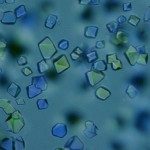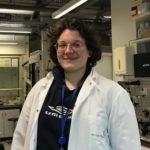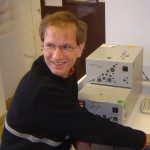Lien vers Pubmed [PMID] – 37607061
Lien vers HAL – pasteur-04188597
Lien DOI – 10.1128/mbio.00706-23
mBio, In press, ⟨10.1128/mbio.00706-23⟩
Flavivirus particle maturation, a process essential for virus infectivity, has been mostly studied using dengue virus. In infected cells, immature icosahedral virions bud into the endoplasmic reticulum. Budding is induced by lateral contacts between heterodimers of transmembrane glycoproteins prM and E. During exocytosis through the trans-Golgi network (TGN), the acidic environment triggers a major particle reorganization in which E forms head-to-tail dimers and furin cleaves prM into globular pr and transmembrane M proteins. pr remains bound to E at acidic pH and blocks its fusogenic activity, but at neutral pH, its affinity for E drops and pr is shed from the particle in the extracellular environment, leaving a virion activated for fusion at low pH. We report here that recombinant yellow fever virus (YFV) pr retains high affinity for soluble E (sE) at neutral pH—significantly shifting the current paradigm. The X-ray structure of the YFV pr/sE complex shows essentially the same pattern of interactions reported for dengue virus, while the X-ray structure of YFV sE at neutral pH shows the same canonical head-to-tail sE dimer. pr binding to the sE dimer is precluded by the E “150-loop,” indicating it must adopt a different conformation in the E dimers on virions at acidic pH for pr binding. We had previously reported a similar local reorganization of the E 150-loop at acidic pH for the tick-borne encephalitis virus, with the important difference that pr stabilized a soluble sE head-to-tail dimer, which is not the case for YFV. IMPORTANCE All enveloped viruses enter cells by fusing their envelope with a target cell membrane while avoiding premature fusion with membranes of the producer cell—the latter being particularly important for viruses that bud at internal membranes. Flaviviruses bud in the endoplasmic reticulum, are transported through the TGN to reach the external milieu, and enter other cells via receptor-mediated endocytosis. The trigger for membrane fusion is the acidic environment of early endosomes, which has a similar pH to the TGN of the producer cell. The viral particles therefore become activated to react to mildly acidic pH only after their release into the neutral pH extracellular environment. Our study shows that for yellow fever virus (YFV), the mechanism of activation involves actively knocking out the fusion brake (protein pr) through a localized conformational change of the envelope protein upon exposure to the neutral pH external environment. Our study has important implications for understanding the molecular mechanism of flavivirus fusion activation in general and points to an alternative way of interfering with this process as an antiviral treatment.










